Manuscript Speculation Tool: Reconstructing Non-extant Portions of Manuscripts
Part II: The Example of Codex sa 2070
by
Diliana Atanassova, Troy A. Griffitts, and Ulrich Schmid
With the Manuscript Speculation Tool, the members of the Göttingen CoptOT Team and other specialists for Coptic biblical manuscripts attempt the reconstruction of missing pages. This tool allows to quickly and systematically estimate the number of missing leaves in between extant leaves as well as the page and quire numbers of fragmentary leaves lacking their upper margins.
We will now show in detail how to use the tool by reconstructing the page numbers for sa 2070.
First of all, one should make an in-depth study of the extant leaves of a codex, in order to properly set the parameters in the tool.
The Deuteronomy codex sa 2070 is comprised today of only 5 leaves containing portions of the chapters Deut 13; Deut 17; Deut 21; Deut 31; Deut 32. It is lacking any quire numbers and therefore they will not be the object of this investigation, though some page numbers are still extant. Only the first two leaves are almost undamaged: Vienna, ÖNB, K 9870 and Leiden, RMO, AES 40–12, which provide the basis for the required information about the number of lines per page as well as the number of letters per line. These two leaves consistently have 31 lines per column and on average 8 – 9 letters per line. However, sporadically we also count 7 or 10 letters per line and, in one case, even 11 letters. Codex sa 2070 is written in 2 columns in the unimodular script of Coptic whose main characteristic is that almost all Coptic letters (an exception being the letter iota) have the same height and width. The presence of this characteristic is of great importance as it makes the results much more reliable.
Second, one should choose in which order the gaps between two extant leaves need to be closed by the means of the tool.
In codex sa 2070, there are three leaves out of five that do not have extant page numbers – Leiden, RMO, AES 40–12 (Deut 17), Paris, BnF, Copte 130.5, f. 137 (Deut 21), and Copte 132.2, f. 48 (Deut 31). The rule of thumb for using the manuscript speculation tool is “The smaller the gap, the less room for error!” Therefore in this codex, we choose to begin our reconstruction with the last leaf containing Deut 31, as the next leaf with extant pagination contains Deut 32. This means that the gap between the two leaves is not big. After that, we will reconstruct the pagination of the Leiden leaf with Deut 17, which follows a Vienna leaf with extant pagination and contains Deut 13. Lastly, speculation will be dedicated to the Paris leaf with its content of Deut 21. In order to minimize the percentage of error, we will use the already reconstructed page numbers of the Leiden leaf (Deut 17) as it is located within the codex structure near the Paris leaf (Deut 21).
Third, two of the parameters require attention as they have a special effect on fine-tuning the result, i.e. Line Width and Space Width. Here the selection of the values requires a few attempts, with a goal to bring the first line of the first column of an extant page in accordance with the last line of the last column of the page.
Now comes the time to put all this information together and recreate the two pages of the Vienna leaf by experimenting with the parameters of the Manuscript Speculation Tool. The two columns and the 31 lines per column are a given, as well as the letter iota that should be treated as a Half-width Character. The Starting Character Number is 77 from the Starting Verse Deut 13.13 and Prefer Wordbreak Within Character Count is set to zero. With some trial and error, it emerges that the best result is achieved by setting Line Width to 8.4 and Space Width to 0.4.
This combination of parameters generates two successive pages which mimic the real object displaying only three letters more. Alternatively, setting Line Width to 8.3 results in a reconstruction that displays 17 letters less than the real object over two successive pages.
So using parameters in this range allows us to speculate on all gaps in sa 2070.
Reconstruction of the page numbers of Paris, BnF, Copte 132.2, f. 48 (Deut 31)
At first glance, someone who does not know the codex would suggest that between the two leaves Copte 132.2, f. 48 (Deut 31) and Copte 129.1, f. 93 (Deut 32) only one or two leaves are missing. However, the tool teaches us that the missing leaves are four because in this unimodular manuscript the letters per line are on average 8–9. The special feature for the reconstruction of this page is the fact that the leaf with the extant page number is following the leaves without page numbers. In such cases, one has to work one's way backward to arrive at the extant page’s missing number.
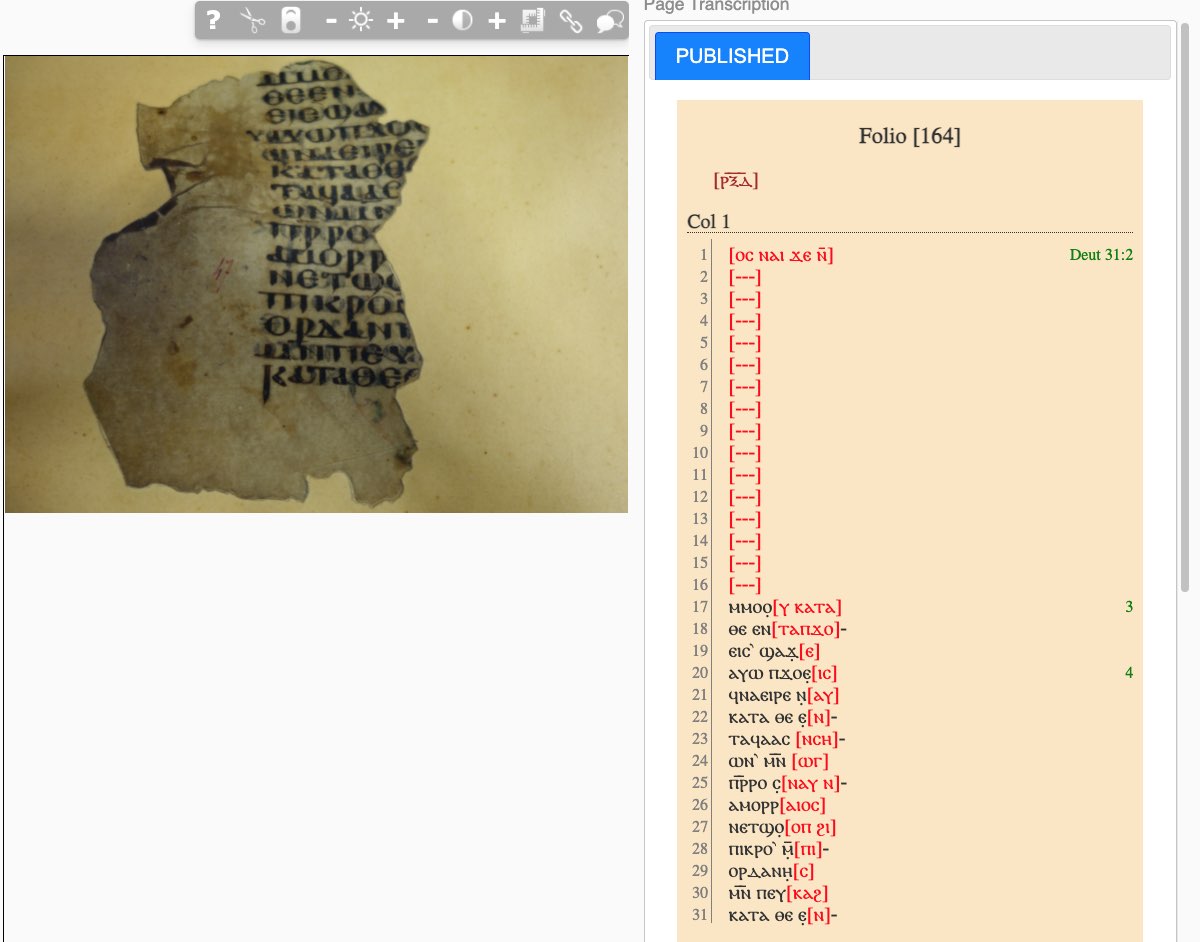
We know exactly how the page [164] begins because we know the wording of the last lines of the previous page.
Then we are aiming at a page with the number 173 that should begin with the end of Deut 32:14 ⲙ̄ⲡⲉ̣ⲗ̣ⲟⲟⲗⲉ
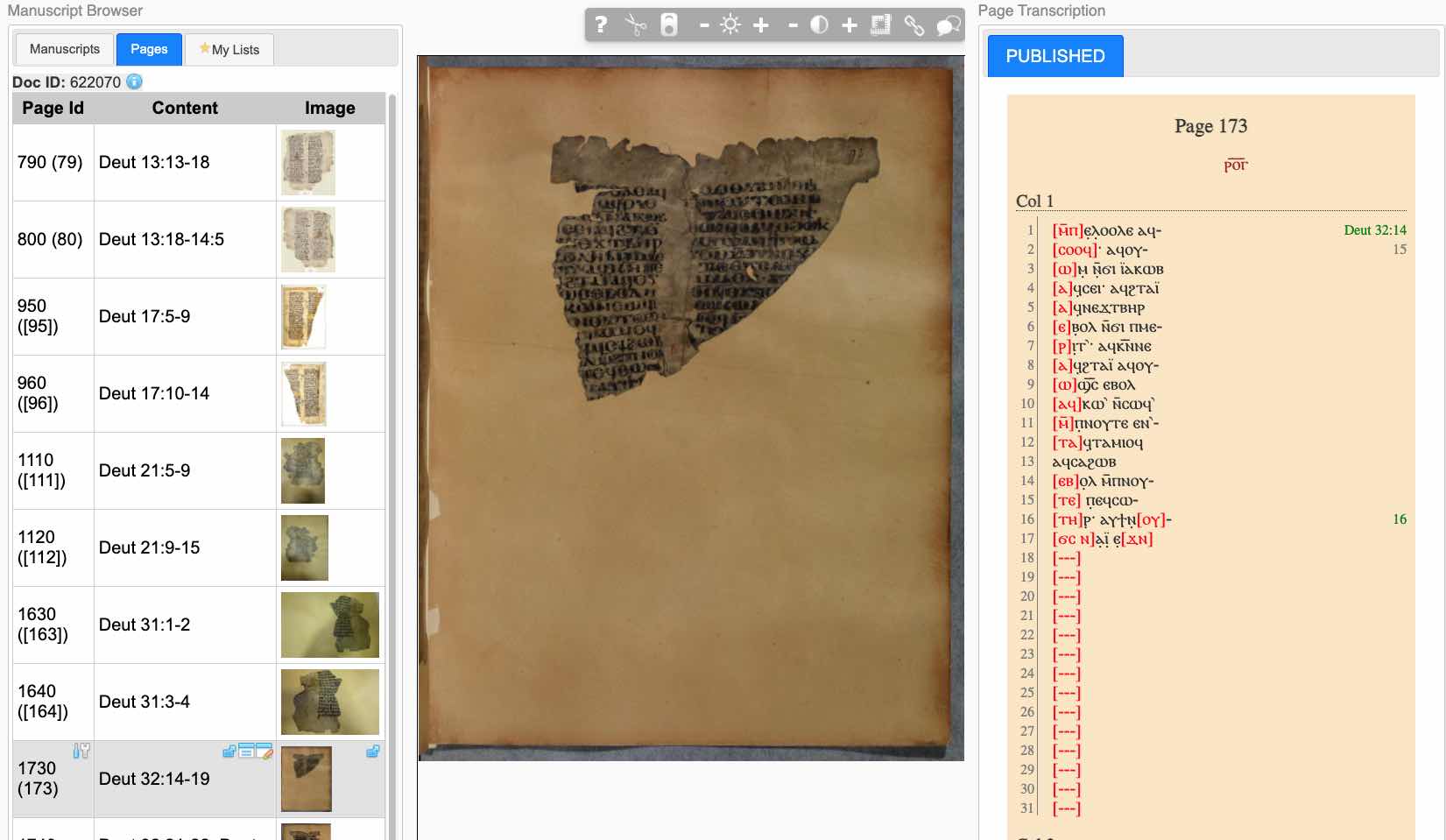
It is important to note that the tool does not claim to reconstruct exactly every line on a page but simply to apply a consistent estimate across the entire speculation; therefore, a certain error rate can be expected and does not contradict the results.
The following parameters include the Line Width 8.4 and mirror exactly the first line of the manuscript on Page [164]. Further down the line Page 173 and Deut. 32:14/15 comes along.
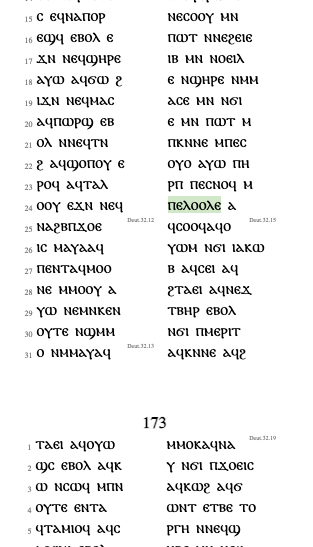
As one can see by the highlighted word which represents the first word of the next extant portion of the manuscript, the reconstruction with the parameter Line Width 8.4 falls short by eight lines or 71 characters of the beginning of page 173.
Below, the speculation with Line Width 8.3 is given.
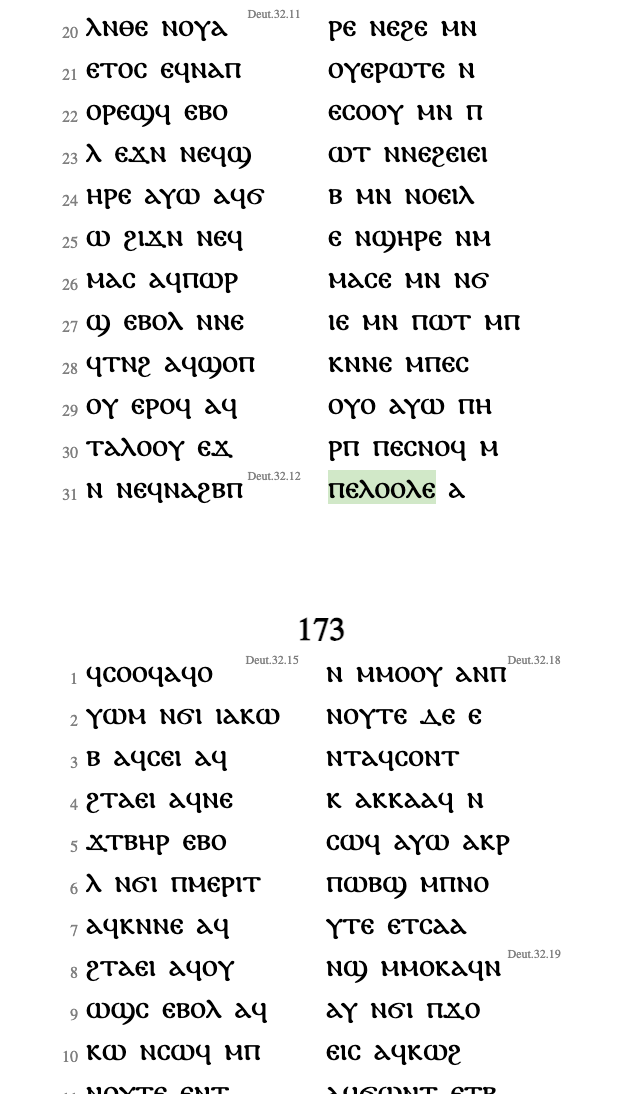
Here we arrive at a reconstruction that is off by only one line or nine characters, which is to be preferred.
Reconstruction of the page numbers of Leiden, RMO, AES 40–12 (Deut 17)
In this case, the page to be reconstructed follows a page with extant page numbers. Since Page 80 ends after the first word of Deut 14:5 we know that our reconstructed Page 81 begins with Starting Character Number 9 of that verse. The end of our gap is bounded by the next extant page which is a recto starting with the end of Deut 17:5 ⲛⲉ ⲉⲣⲟⲟⲩ.
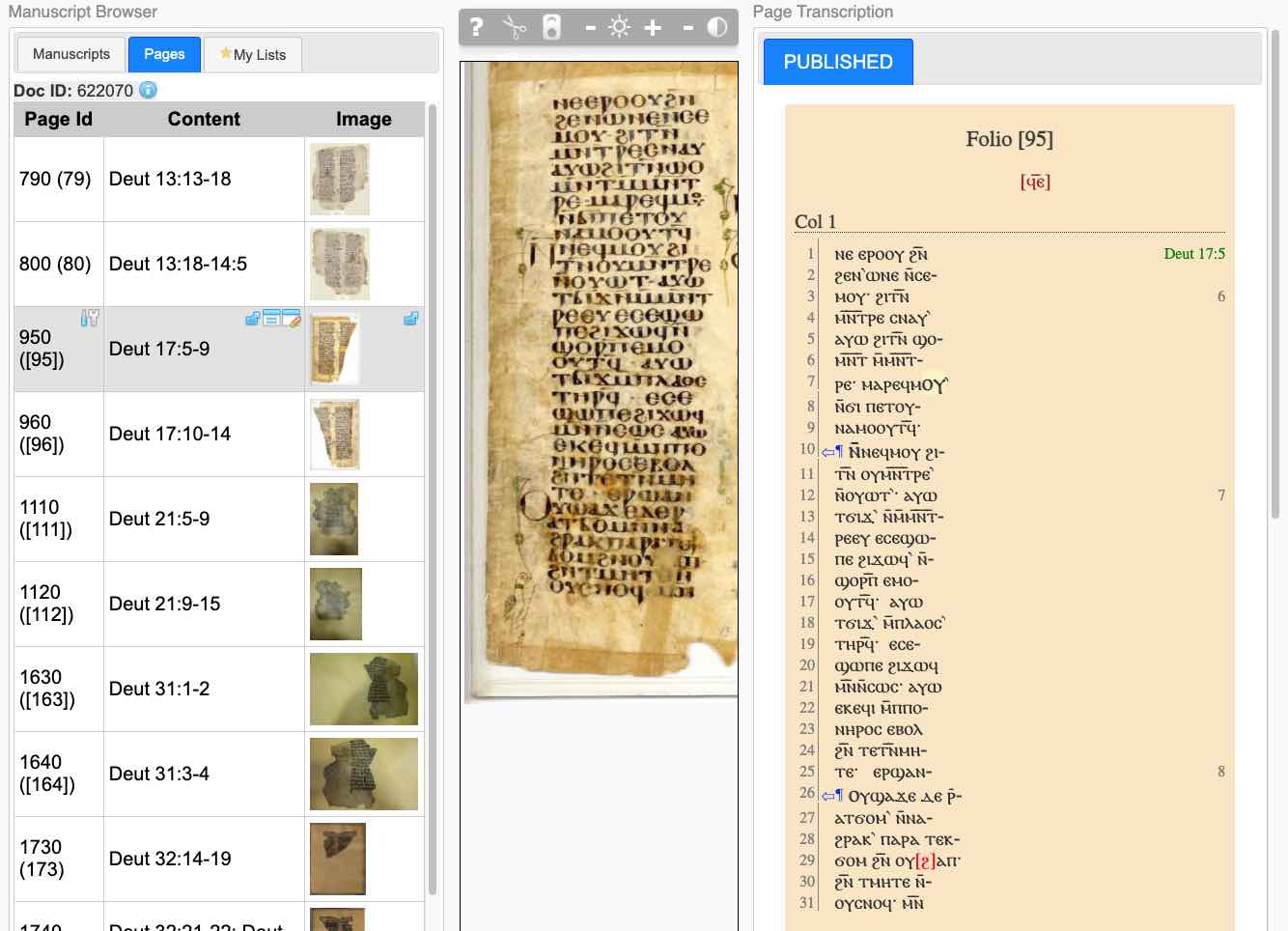
Again, we start with Line Width 8.4 and employ the following parameter set
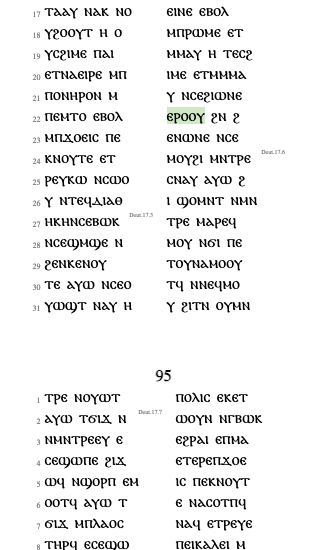
This time, the error rate amounts to about 10 lines with 87 characters short of the next recto.
As an alternative, we also provide the result for Line Width 8.3.

This speculation is only one line with seven letters short of the next recto. This indicates, again, that the parameter set with Line Width 8.3 gives better results.
Reconstruction of the page numbers of Paris, BnF, Copte 130.5, f. 137 (Deut 21)
In order to minimize the error rate, we continue our reconstruction starting with the page following our previously reconstructed page [96]. As we know exactly how page [96] ends, we can say that the next page will begin in the middle of Deut. 17:14 – at character offset 121.

This time, we are aiming at a fragment that includes Deut 21:5 at about the middle of the first column of a recto.

Again, we start with Line Width 8.4 and employ the following parameter set.

In addition, we give the speculation for Line Width 8.3 parameter set.
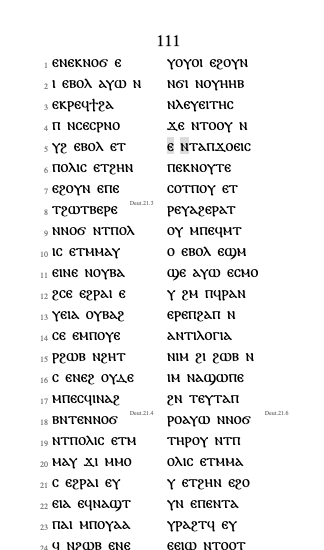
This time for both cases the speculation is off by a comparatively large margin. The best result is found with the first set of parameters with an error margin of 10 lines with 88 characters. The second set of parameters produces an error margin is 20 lines with 172 characters. In addition, the latter set displays the targeted passage on the second column of a recto. In both cases, however, the targeted passage is found on the same page, i.e. page [111]. Therefore, we should be reasonably confident that the overall reconstruction is accurate. With a gap of 16 pages to be reconstructed, our error rate is still less than one line per page.
By reconstructing the gaps of codex sa 2070 we hope to have been able to show you the advantages of the Manuscript Speculation tool.
 Blogs
Blogs  Recent Bloggers
Recent Bloggers 




